Transmission of Orbital Angular Momentum and Cylindrical Vector Beams in a Large-Bandwidth Annular Core Photonic Crystal Fiber
Abstract
1. Introduction
2. Mode structure and Attenuation in AC-PCF
3. Experimental Setup and Discussion
4. Conclusions
Author Contributions
Funding
Acknowledgments
Conflicts of Interest
Appendix A
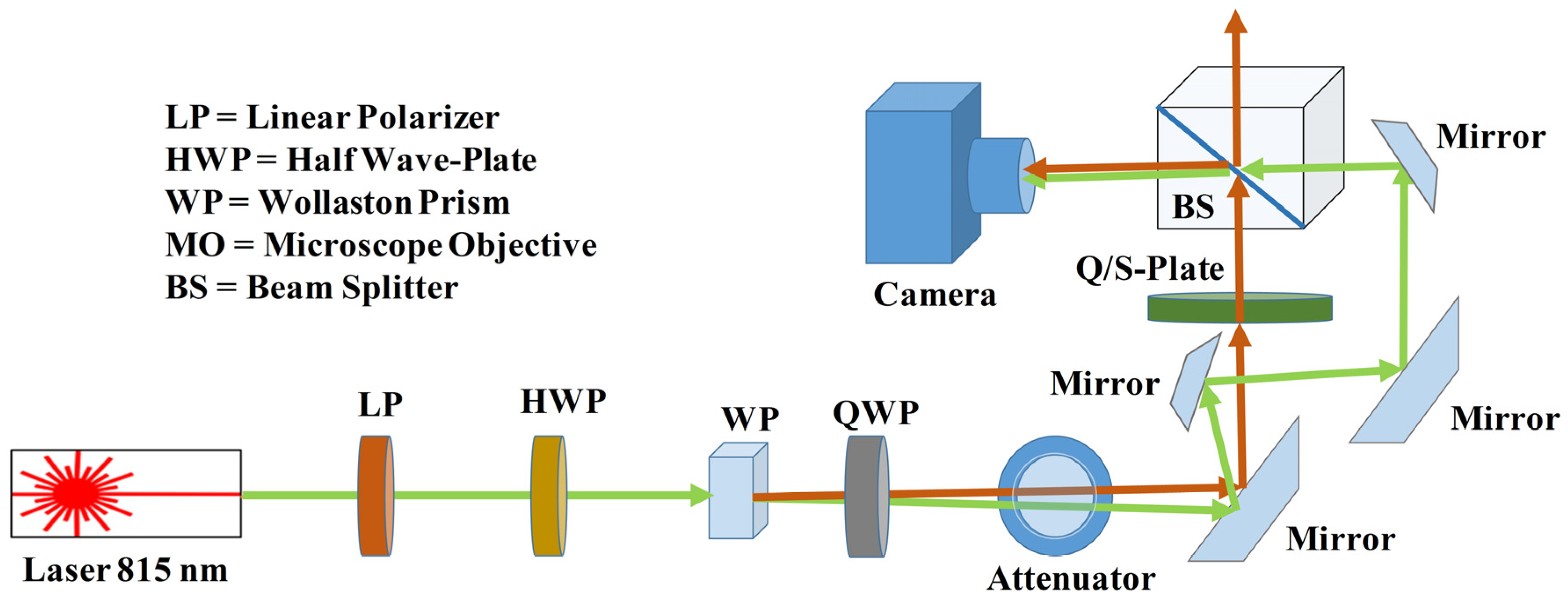
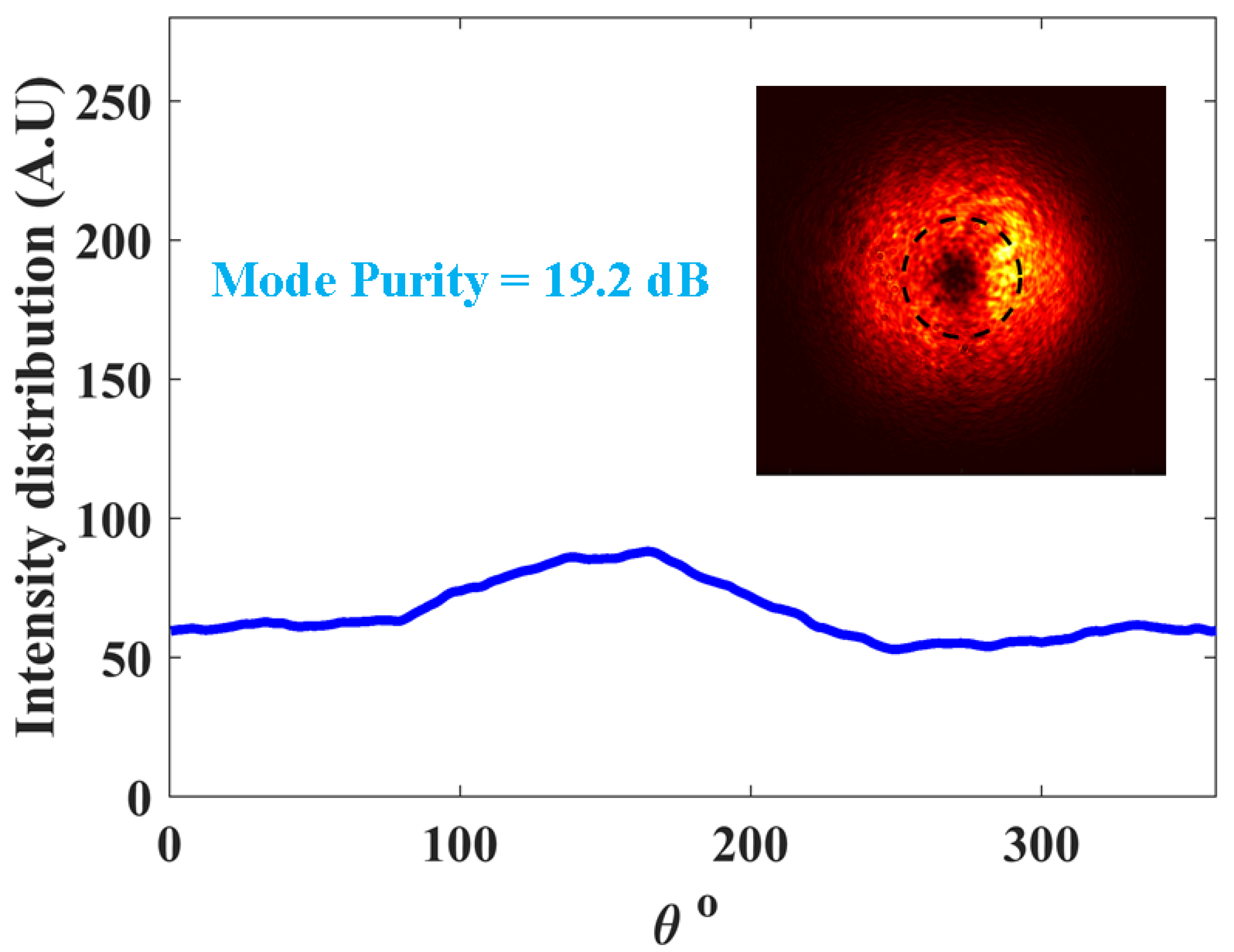
References
- Zhan, Q. Cylindrical vector beams: From mathematical concepts to applications. Adv. Opt. Photonics 2009, 1, 1. [Google Scholar] [CrossRef]
- Allen, L.; Beijersbergen, M.; Spreeuw, R.J.C.; Woerdman, J.P. Orbital angular momentum of light and the transformation of Laguerre-Gaussian laser modes. Phys. Rev. A 1992, 45, 8185–8189. [Google Scholar] [CrossRef] [PubMed]
- Yao, A.M.; Padgett, M.J. Orbital angular momentum: Origins, behavior and applications. Adv. Opt. Photonics 2011, 3, 161–204. [Google Scholar] [CrossRef]
- Andersen, M.F.; Ryu, C.; Cladé, P.; Natarajan, V.; Vaziri, A.; Helmerson, K.; Phillips, W. Quantized Rotation of Atoms from Photons with Orbital Angular Momentum. Phys. Rev. Lett. 2006, 97, 170406. [Google Scholar] [CrossRef] [PubMed]
- Padgett, M.J.; Bowman, R. Tweezers with a twist. Nat. Photonics 2011, 5, 343–348. [Google Scholar] [CrossRef]
- Ren, Y.; Li, L.; Wang, Z.; Kamali, S.M.; Arbabi, E.; Arbabi, A.; Zhao, Z.; Xie, G.; Cao, Y.; Ahmed, N.; et al. Orbital Angular Momentum-based Space Division Multiplexing for High-capacity Underwater Optical Communications. Sci. Rep. 2016, 6, 33306. [Google Scholar] [CrossRef]
- Willner, A.E.; Huang, H.; Yan, Y.; Ren, Y.; Ahmed, N.; Xie, G.; Bao, C.; Li, L.; Cao, Y.; Zhao, Z.; et al. Optical communications using orbital angular momentum beams. Adv. Opt. Photonics 2015, 7, 66–106. [Google Scholar] [CrossRef]
- Bovino, F.A.; Braccini, M.; Bertolotti, M.; Sibilia, C. Management of the orbital angular momentum of vortex beams in a quadratic nonlinear interaction. Opt. Commun. 2011, 284, 2587–2593. [Google Scholar] [CrossRef][Green Version]
- Schmiegelow, C.T.; Schulz, J.; Kaufmann, H.; Ruster, T.; Poschinger, U.; Schmidt-Kaler, F. Transfer of optical orbital angular momentum to a bound electron. Nat. Commun. 2016, 7, 12998. [Google Scholar] [CrossRef]
- Brullot, W.; Vanbel, M.K.; Swusten, T.; Verbiest, T. Resolving enantiomers using the optical angular momentum of twisted light. Sci. Adv. 2016, 2, e1501349. [Google Scholar] [CrossRef]
- Youngworth, K.; Brown, T. Focusing of high numerical aperture cylindrical-vector beams. Opt. Express 2000, 7, 77. [Google Scholar] [CrossRef] [PubMed]
- Kozawa, Y.; Matsunaga, D.; Sato, S. Superresolution imaging via superoscillation focusing of a radially polarized beam. Optica 2018, 5, 86–92. [Google Scholar] [CrossRef]
- Drevinskas, R.; Zhang, J.; Beresna, M.; Gecevičius, M.; Kazanskii, A.G.; Svirko, Y.P.; Kazansky, P. Laser material processing with tightly focused cylindrical vector beams. Appl. Phys. Lett. 2016, 108, 221107. [Google Scholar] [CrossRef]
- Kozawa, Y.; Sato, S. Optical trapping of micrometer-sized dielectric particles by cylindrical vector beams. Opt. Express 2010, 18, 10828–10833. [Google Scholar] [CrossRef]
- Brunet, C.; Rusch, L.A. Optical fibers for the transmission of orbital angular momentum modes. Opt. Fiber Technol. 2017, 35, 2–7. [Google Scholar] [CrossRef]
- Brunet, C.; Ung, B.; Wang, L.; Messaddeq, Y.; LaRochelle, S.; Rusch, L.A. Design of a family of ring-core fibers for OAM transmission studies. Opt. Express 2015, 23, 10553–10563. [Google Scholar] [CrossRef]
- Brunet, C.; Vaity, P.; Messaddeq, Y.; LaRochelle, S.; Rusch, L.A. Design, fabrication and validation of an OAM fiber supporting 36 states. Opt. Express 2014, 22, 26117–26127. [Google Scholar] [CrossRef]
- Gregg, P.; Kristensen, P.; Ramachandran, S. Conservation of orbital angular momentum in air-core optical fibers. Optica 2015, 2, 267. [Google Scholar] [CrossRef]
- Ramachandran, S.; Gregg, P.; Kristensen, P.; Golowich, S.E. On the scalability of ring fiber designs for OAM multiplexing. Opt. Express 2015, 23, 3721–3730. [Google Scholar] [CrossRef]
- Ramachandran, S.; Kristensen, P.; Yan, M.F. Generation and propagation of radially polarized beams in optical fibers. Opt. Lett. 2009, 34, 2525–2527. [Google Scholar] [CrossRef]
- Zhang, H.; Zhang, X.; Li, H.; Deng, Y.; Xi, L.; Tang, X.; Zhang, W. The Orbital Angular Momentum Modes Supporting Fibers Based on the Photonic Crystal Fiber Structure. Crystals 2017, 7, 286. [Google Scholar] [CrossRef]
- Zhang, L.; Zhang, K.; Peng, J.; Deng, J.; Yang, Y.; Ma, J. Circular photonic crystal fiber supporting 110 OAM modes. Opt. Commun. 2018, 429, 189–193. [Google Scholar] [CrossRef]
- Pakarzadeh, H.; Sharif, V. Control of orbital angular momentum of light in optofluidic infiltrated circular photonic crystal fibers. Opt. Commun. 2019, 438, 18–24. [Google Scholar] [CrossRef]
- Tandje, A.; Yammine, J.; Bouwmans, G.; Dossou, M.; Vianou, A.; Andresen, E.R.; Bigot, L. Design and Fabrication of a Ring-Core Photonic Crystal Fiber for Low-Crosstalk Propagation of OAM Modes. In Proceedings of the 2018 European Conference on Optical Communication (ECOC), Rome, Italy, 23–27 September 2018; pp. 1–3. [Google Scholar]
- Hu, Z.-A.; Huang, Y.-Q.; Luo, Z.-C.; Cui, H.; Xu, W.-C. Photonic crystal fiber for supporting 26 orbital angular momentum modes. Opt. Express 2016, 24, 17285. [Google Scholar] [CrossRef] [PubMed]
- Yue, Y.; Zhang, L.; Yan, Y.; Ahmed, N.; Yang, J.-Y.; Huang, H.; Ren, Y.; Dolinar, S.; Tur, M.; Willner, A.E. Octave-spanning supercontinuum generation of vortices in an As2S3 ring photonic crystal fiber. Opt. Lett. 2012, 37, 1889–1891. [Google Scholar] [CrossRef] [PubMed]
- Sharma, M.; Pradhan, P.; Ung, B. Endlessly mono-radial annular core photonic crystal fiber for the broadband transmission and supercontinuum generation of vortex beams. Sci. Rep. 2019, 9, 2488. [Google Scholar] [CrossRef]
- Tandjè, A.; Yammine, J.; Dossou, M.; Bouwmans, G.; Baudelle, K.; Vianou, A.; Andresen, E.R.; Bigot, L. Ring-core photonic crystal fiber for propagation of OAM modes. Opt. Lett. 2019, 44, 1611–1614. [Google Scholar] [CrossRef]
- Zhu, Z.; Brown, T. Analysis of the space filling modes of photonic crystal fibers. Opt. Express 2001, 8, 547–554. [Google Scholar] [CrossRef]
- Altechna. Available online: https://www.altechna.com/products/s-waveplate-radial-polarization-converter/ (accessed on 3 April 2020).
- Pradhan, P.; Sharma, M.; Ung, B. Generation of Perfect Cylindrical Vector Beams with Complete Control over the Ring Width and Ring Diameter. IEEE Photonics J. 2018, 10, 1–10. [Google Scholar] [CrossRef]
- Zhang, H.; Mao, B.; Han, Y.; Wang, Z.; Yue, Y.; Liu, Y.-G. Generation of Orbital Angular Momentum Modes Using Fiber Systems. Appl. Sci. 2019, 9, 1033. [Google Scholar] [CrossRef]
- Gecevicius, M.; Ivanov, M.; Beresna, M.; Matijosius, A.; Tamulienė, V.; Gertus, T.; Cerkauskaite, A.; Redeckas, K.; Vengris, M.; Smilgevicius, V.; et al. Toward the generation of broadband optical vortices: Extending the spectral range of a q-plate by polarization-selective filtering. J. Opt. Soc. Am. B 2017, 35, 190–196. [Google Scholar] [CrossRef]
- Siegman, A.; Sasnett, M.; Johnston, T. Choice of clip levels for beam width measurements using knife-edge techniques. IEEE J. Quantum Electron. 1991, 27, 1098–1104. [Google Scholar] [CrossRef]
- Bozinović, N.; Kristensen, P.; Ramachandran, S. Long-range fiber-transmission of photons with orbital angular momentum. In Proceedings of the Conference on Lasers and Electro-Optics, Munich, Germany, 22–26 May 2011; p. 1. [Google Scholar]
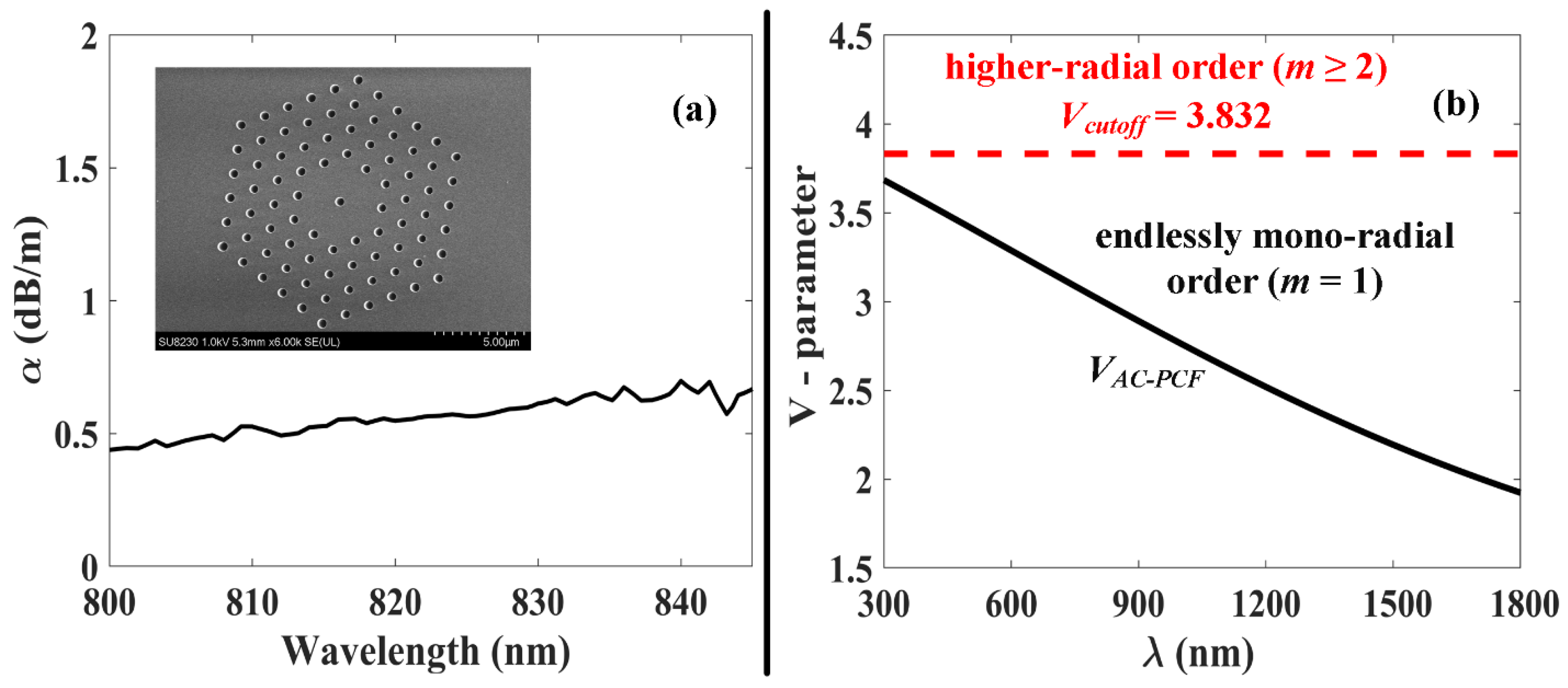
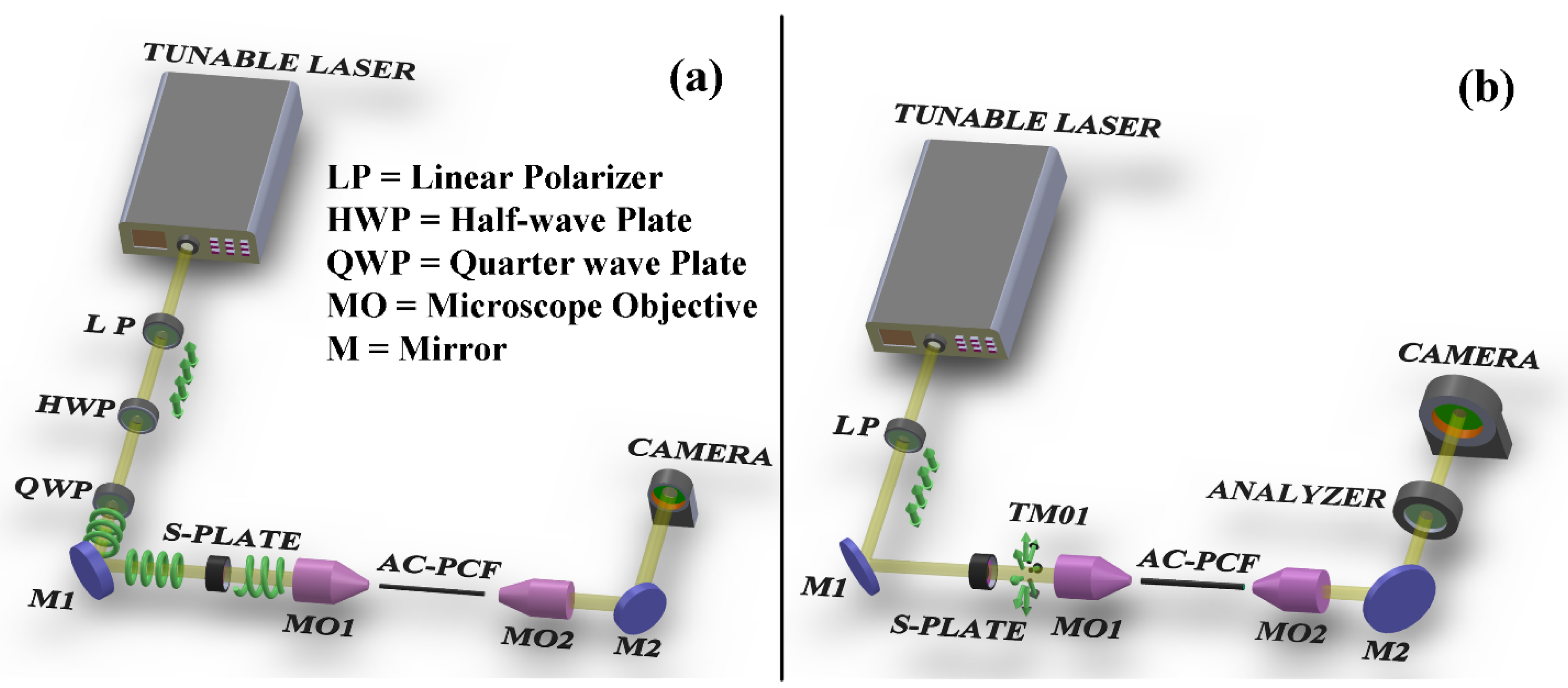
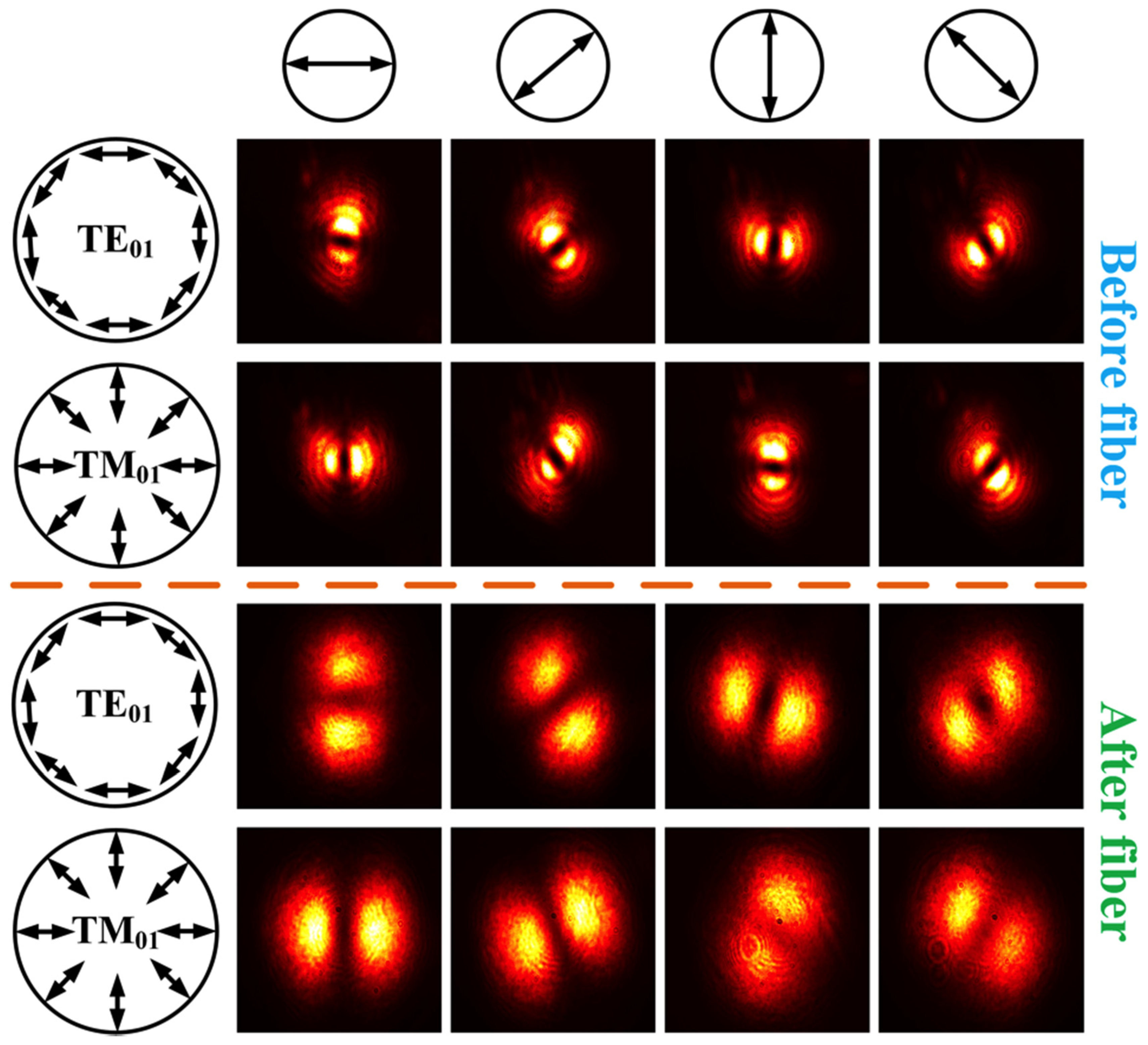
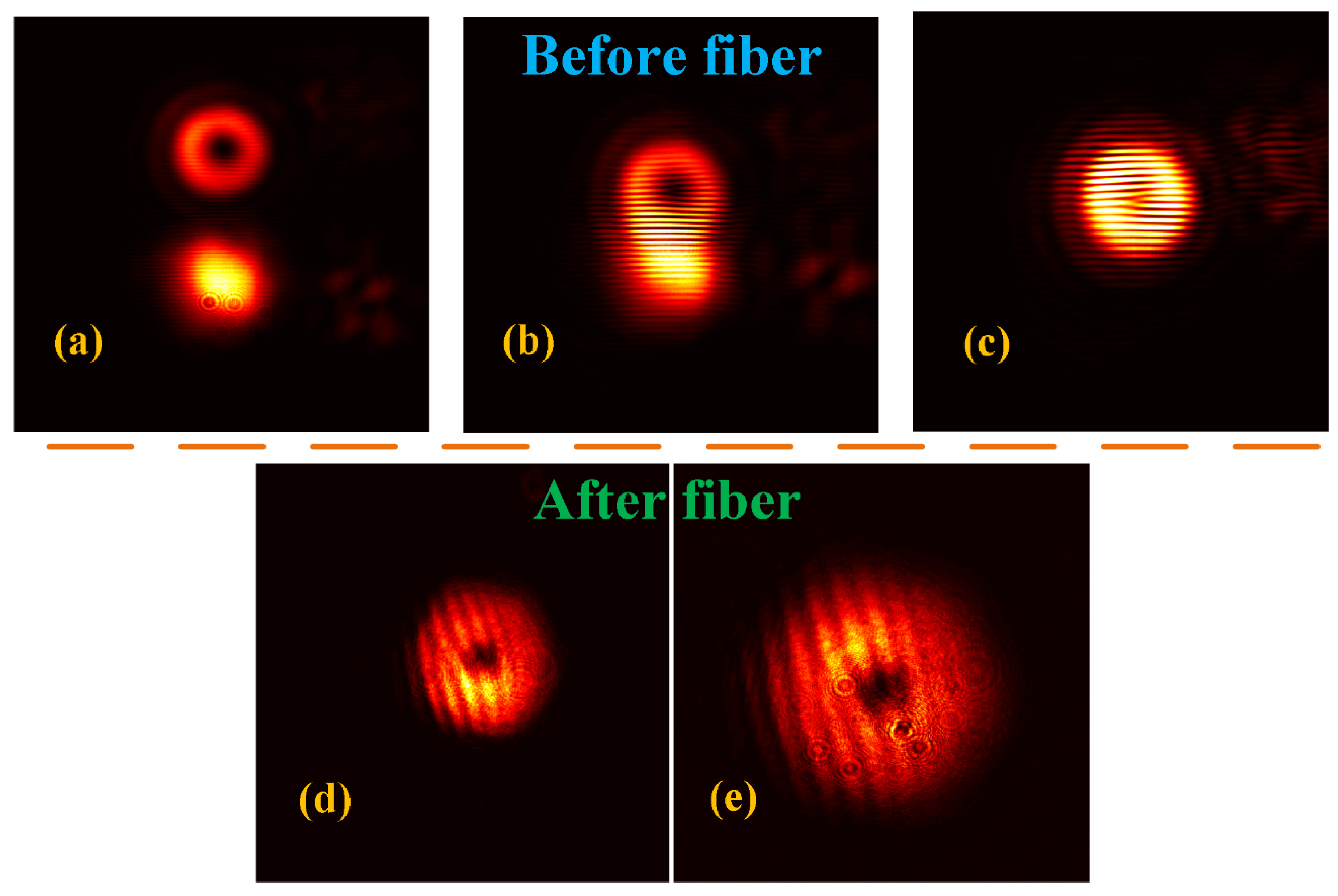
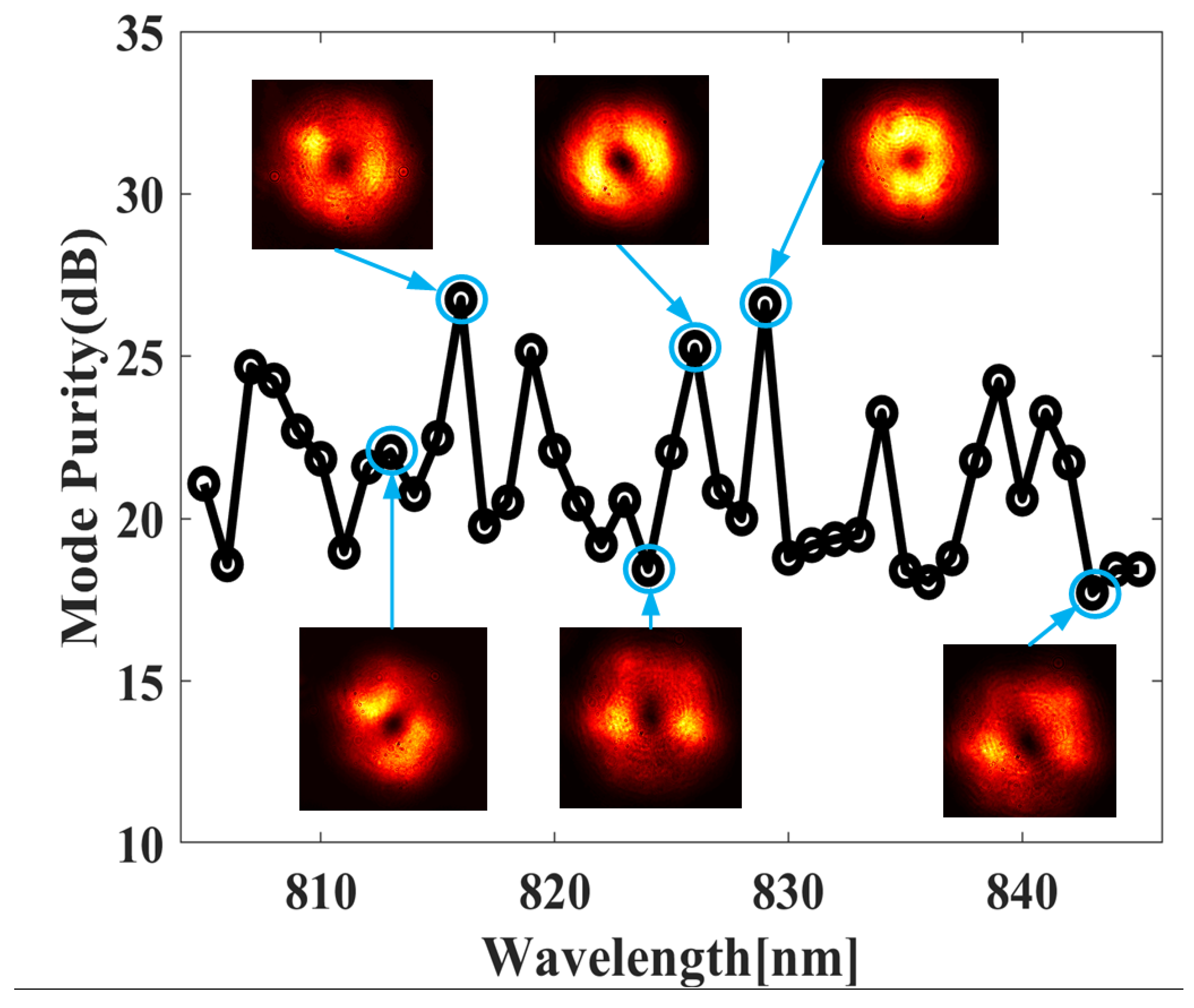
© 2020 by the authors. Licensee MDPI, Basel, Switzerland. This article is an open access article distributed under the terms and conditions of the Creative Commons Attribution (CC BY) license (http://creativecommons.org/licenses/by/4.0/).
Share and Cite
Sharma, M.; Amirkhan, F.; Mishra, S.K.; Sengupta, D.; Messaddeq, Y.; Blanchard, F.; Ung, B. Transmission of Orbital Angular Momentum and Cylindrical Vector Beams in a Large-Bandwidth Annular Core Photonic Crystal Fiber. Fibers 2020, 8, 22. https://doi.org/10.3390/fib8040022
Sharma M, Amirkhan F, Mishra SK, Sengupta D, Messaddeq Y, Blanchard F, Ung B. Transmission of Orbital Angular Momentum and Cylindrical Vector Beams in a Large-Bandwidth Annular Core Photonic Crystal Fiber. Fibers. 2020; 8(4):22. https://doi.org/10.3390/fib8040022
Chicago/Turabian StyleSharma, Manish, Fatemeh Amirkhan, Satyendra K. Mishra, Dipankar Sengupta, Younès Messaddeq, François Blanchard, and Bora Ung. 2020. "Transmission of Orbital Angular Momentum and Cylindrical Vector Beams in a Large-Bandwidth Annular Core Photonic Crystal Fiber" Fibers 8, no. 4: 22. https://doi.org/10.3390/fib8040022
APA StyleSharma, M., Amirkhan, F., Mishra, S. K., Sengupta, D., Messaddeq, Y., Blanchard, F., & Ung, B. (2020). Transmission of Orbital Angular Momentum and Cylindrical Vector Beams in a Large-Bandwidth Annular Core Photonic Crystal Fiber. Fibers, 8(4), 22. https://doi.org/10.3390/fib8040022




